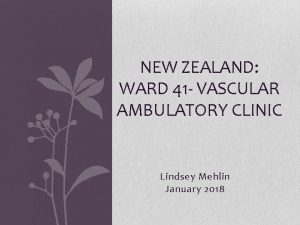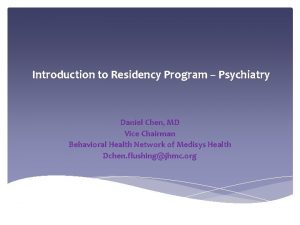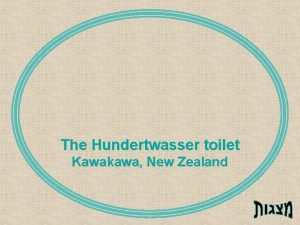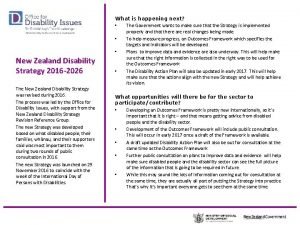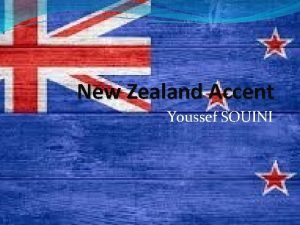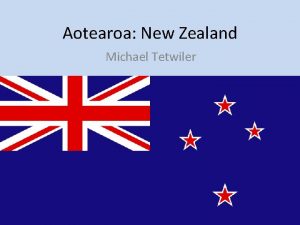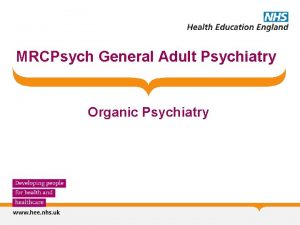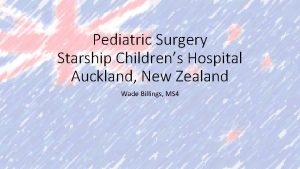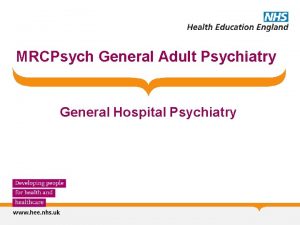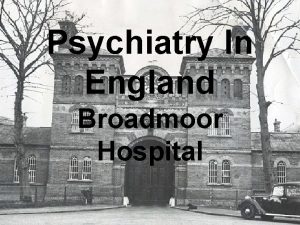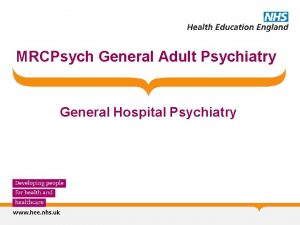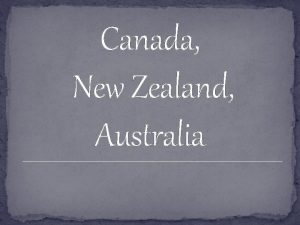New Zealand Liaison Psychiatry North Shore Hospital Auckland














- Slides: 14

New Zealand Liaison Psychiatry, North Shore Hospital, Auckland, NZ Zachary Schwab KU SOM, Class of 2017

Kiwi Facts • Island in the Southern Hemisphere near Australia • Two major islands – North and South • Time zone difference of 19 hours from Kansas • Physically the size of Colorado • Population of 4. 5 million • Auckland is the largest city • 1. 5 million people • Fourth most expensive city in the world • Maori is the official language • English is spoken by 97% of residents • Diversity: • Maori - 15% of residents • Only 75% of all residents were born in New Zealand • Many from the UK, Southeast Asia, and Australia

Auckland, New Zealand

Liaison Psychiatry, North Shore Hospital

Health Care in New Zealand • The Accident Compensation Corporation (ACC) • Covers cost of treatment for accidents for all people legally in New Zealand (including tourists) • Public hospital system • Treats residents free of charge • Managed by District Health Boards • Private insurance system • About 25% of residents participate

Clinical Experience One of my most profound clinical experiences involved an elderly woman with paranoid ideation. She was admitted to the hospital after she had fallen in her home and broken her hip; she was also found to have a urinary tract infection. She had no history of bizarre behavior or psychiatric illness. During her second day in the hospital, she began to express paranoid delusions and made statements that suggested she was having visual hallucinations. Her chart read, “Patient is pleasant with labile affect and tangential thought content. She wanted some tea, but was not keen on the cup on her tray because it was ‘covered in ants. ’ The cup was not covered in ants. ” The liaison psychiatry team was consulted to determine what was going on and to give advice on how her condition could be treated. Her medical conditions on admission, her age, and her inpatient stay in the hospital were all risk factors for delirium, which was our final diagnosis. Interestingly, the woman’s paranoia revolved around the hospital and staff. She was convinced that the nurses and doctors were imposters; they were actors, not medical professionals. In fact, she was convinced that she wasn’t in a hospital at all and asked to be wheeled to the lobby to see if it truly existed. In addition, she refused hip surgery and feared that she would instead receive brain surgery against her will. She asked several times to be transferred to another hospital. However, due to the national health care system in New Zealand, she didn’t really have much of a choice. She may have been able to potentially find a private surgeon elsewhere, but it wouldn’t be covered by insurance. Eventually, she agreed to take a low dose of antipsychotic medication and improved over a few days. She later apologized to the staff for her “dreadful behavior. ”

The Maori People • Indigenous Polynesian people of New Zealand • Arrived between 1250 and 1300

History: British Colonization • Europeans arrived in New Zealand in the 17 th Century • Initially, largely amicable relationship • Treaty of Waitangi signed in 1840 • In the 1860 s, decades of conflict began between European settlers and the native Maori people • New Zealand Wars “Kororāreka Beach” by Augustus Earle

The Maori People: Socioeconomic Disparities • Maori have higher rates of poverty • Unemployment rates twice as high as non-Maori • Maori make up only 14% of the New Zealand population, but account for nearly 50% of the prison population

Maori Culture and Western Medicine • Rongoa – Maori traditional medicine • Includes herbal medicine from plants, holistic spiritual healing, and use of physical techniques such as massage • Patients rely on cultural leaders and family input • Kaumatua – elected tribal leaders • Many Maori people are reluctant to embrace Western medicine • Less frequent use of health care services

The Maori People: Health Disparities • Late diagnosis and treatment intervention • Higher rates of cervical cancer and diabetes • High rates of obesity and smoking • Psychiatry: • Higher rates of alcohol and drug dependence • Elevated suicide rate • Twice as high as non-Maori in men ages 15 -24 • Decreased life expectancy • Maori live about 8 years less than non-Maori people

Working Together • Important to have meetings that include family and cultural or spiritual leaders • Critical for adherence to medical plan • Education is very important • Goal to increase health literacy • Marae – a traditional meeting place • May be incorporated as part of hospital • Karakia – traditional welcoming and closing song • Maori health teams • Teams designed specifically for Maori health care • Include native Maori speakers and members of community • Available in district health boards across New Zealand

Cultural Experience Within New Zealand, the native Maori population is a special group with their own cultural norms. My most profound and unique cultural experience came when working with a Maori man in his 50 s who was seen by psychiatry due to severe depression. He had been diagnosed with erectile dysfunction and became incredibly distraught. He believed that his inability to achieve an erection meant that he was no longer a man. In his opinion, which he said was representative of greater Maori culture, he was no longer fit to lead his household. He had frequent thoughts of suicide and refused to even consider taking any kind of Western antidepressant medication. He ultimately agreed to therapy with a special Maori outpatient team.

References • • "2013 Census Quick. Stats about culture and identity – Languages spoken". stats. govt. nz. Statistics New Zealand. Retrieved 28 March 2017. Demographia International Housing Affordability Survey. www. demographia. com/dhi. pdf. Retrieved 28 March 2017. Collins, Simon (October 2010). "Ethnic mix changing rapidly". New Zealand Herald. Retrieved 28 March 2017. "2013 Census Quick. Stats about culture and identity – Ethnic groups in New Zealand". stats. govt. nz. Statistics New Zealand. Retrieved 28 March 2017. Kiwi bird image. https: //images. sciencedaily. com/2015/07/150723083731_1_900 x 600. jpg. Retrieved 30 March 2017. "Over-representation of Maori in the criminal justice system" (PDF). Department of Corrections. September 2007. p. 4. Retrieved 28 March 2017. University of Otago, NZ, Suicide Rates in New Zealand–Exploring Associations with Social and Economic Factors. Retrieved 28 March 2017. New Zealand Ministry of Health. http: //www. health. govt. nz. Retrieved 28 March 2017.
 Ward 41 auckland hospital
Ward 41 auckland hospital Jamaica hospital psychiatry residency
Jamaica hospital psychiatry residency Steamship america a north shore legend
Steamship america a north shore legend North shore triathlon
North shore triathlon North shore travel
North shore travel Mean girls cafeteria map
Mean girls cafeteria map Hundertwasser toilet new zealand
Hundertwasser toilet new zealand New zealand official languages english
New zealand official languages english New zealand disability strategy
New zealand disability strategy When was new zealand discovered
When was new zealand discovered New zealand vs australian accent
New zealand vs australian accent Lesson 1 physical geography of australia and new zealand
Lesson 1 physical geography of australia and new zealand Alpha lipid milk benefits
Alpha lipid milk benefits New zealand hotspots
New zealand hotspots New zealand official languages english
New zealand official languages english
